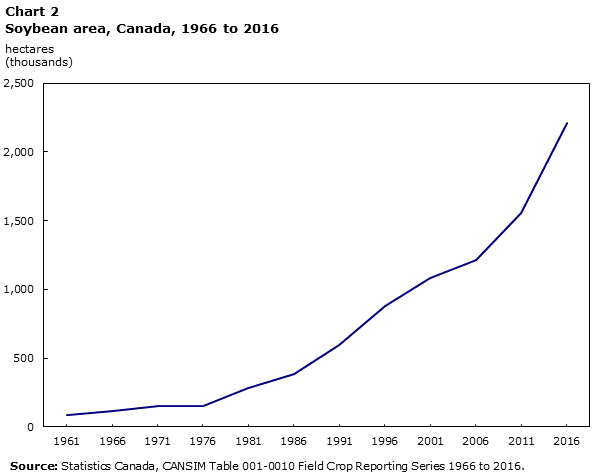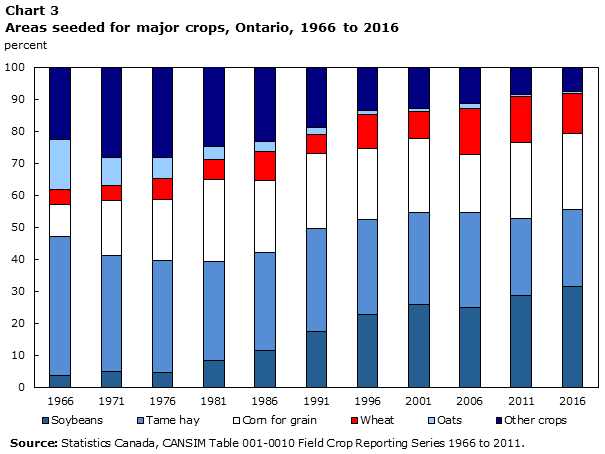VISTA on the Agri-food Industry and the Farm Community
Soy Story: A Short History of Glycine max in Canada
Archived Content
Information identified as archived is provided for reference, research or recordkeeping purposes. It is not subject to the Government of Canada Web Standards and has not been altered or updated since it was archived. Please "contact us" to request a format other than those available.
by Jeannine Cloutier
From foreign interloper to corn's best friend
The soybean plant (Glycine max) was once a novelty crop on Canadian research farms. It has since become a profitable crop rotation partner for corn producers, and its seeds have become Canadians’ main source of edible oils.
Soybeans move to America and become margarine
A staple of Asian cuisine, soybeans are traditionally eaten in fermented form or incorporated into products after being dried and ground, while soybean pods can be enjoyed fresh when in season. The humble soybean's first recorded culinary applications date back to the 11th century B.C. in Northern China.
Agricultural research papers from the mid-1800s provide the earliest documentation of soybeans being grown in North America. In 1879, Rutgers Agricultural College in New Jersey published a report involving soybeans, and the Ontario Agriculture College conducted soybean research trials in 1893.
On this continent, soybean plants were grown initially as a forage crop in the southern United States. Further to the disruption of trade routes during World War II, which restricted the importation of edible fats and oils, the production of soybean as an oilseed crop expanded to fill the import gap, and soybeans moved into the corn-producing regions of North America.
Soybeans have since become the main source of edible fats and oils consumed in North America. Soybean oil is now found in salad dressing, mayonnaise, cooking oil, shortening and margarine, as well as in many processed foods.
Excellent source of protein
Once the oil has been extracted from a soybean, there is still plenty of solid substance left over. This material is commonly referred to as “soybean meal.” Almost half of the dry weight of soybean meal is protein. This makes it an ideal ingredient in animal feed (See Table 1). Wheat (at 11.5%) and corn (at 7.7%) have a much lower protein content by comparison.
| Feed ingredient | Protein | Fat | Fibre |
|---|---|---|---|
| % | |||
| Soybean meal | 47.5 | 1.0 | 3.5 |
| Corn Grain | 7.7 | 3.7 | 2.0 |
| Wheat | 11.5 | 1.9 | 3.3 |
| Barley | 10.5 | 1.9 | 3.0 |
| Grain Sorghum | 9.4 | 2.9 | 2.0 |
| Canola meal | 36.0 | 3.5 | 12.0 |
| Source: ADM feed ingredients catalogue, 2015. | |||
Secondary benefits
Soybeans are more likely to be adopted by farmers in corn-growing regions since the characteristics of Glycine max (the Latin term for soybean) make this crop plant an ideal rotation partner with corn.
The soybean plant has small nodules throughout its root system. These provide “room and board” for soil bacteria, which convert atmospheric nitrogen into nitrogen that becomes available to plants.
What this means for farmers is that a field in which soybeans are grown will likely have more plant-available nitrogen than a field in which another crop was cultivated. Growing soybeans thus reduces the need for chemical fertilizers. Because corn requires a great deal of plant-available nitrogen to achieve maximum yields, it is advantageous to grow corn after soybean.
Disease and insect pressures mount when corn is grown in the same field year after year. From an evolutionary point of view, soybeans (a broad-leafed plant) branched off from corn (a grass) a very long time ago. The two plants differ significantly in their genetic and physiological traits. Many pests of corn (e.g., corn ear rootworm) cannot survive in a soybean field. Therefore, a crop rotation that includes corn and soybean reduces the need for both fertilizers and pesticides and, consequently, results in savings for farmers.
Expansion within Canada
Soybeans have been cultivated on a small scale in a few select pockets of southwestern Ontario (near Windsor) since the 1920s, but real growth in the number of farms producing soybean started in the mid-1970s.
The number of farms in Canada was in consistent decline between 1961 and 2011. The number of farms in Canada has dropped from a high of slightly over 480,000, in 1961 to around 205,000, in 2011 (a 57.2% decrease). During the same period, the number of farms reporting soybean cultivation, however, increased from 7,500, (1.6% of all farms) in 1961 to a high of slightly over 27,000 (13.2% of all farms), in 2011.

Data table for Chart 1
| Year | Number of farms in Canada | Percentage of farms with soybean |
|---|---|---|
| number | percent | |
| 1961 | 480,877 | 1.6 |
| 1966 | 430,503 | 1.8 |
| 1971 | 366,110 | 2.1 |
| 1976 | 338,552 | 2.2 |
| 1981 | 318,361 | 3.3 |
| 1986 | 293,089 | 4.3 |
| 1991 | 280,043 | 5.7 |
| 1996 | 276,548 | 8.0 |
| 2001 | 246,923 | 10.0 |
| 2006 | 229,373 | 10.1 |
| 2011 | 205,730 | 13.2 |
| Source: Statistics Canada, Census of Agriculture, 1961 to 2011. | ||
Adapting to the cold
In the early 1970s, several new soybean varieties, with a shorter growing season and higher cold tolerance, were introduced. This genetic improvement in the crop allowed for the outward expansion of soybean production from the few regions in southwestern Ontario that are warm enough to grow the varieties used by U.S. farmers.
In the mid-1970s, the University of Guelph conducted field trials and released recommendations on how best to grow soybeans in Ontario. Soybean farmers incorporated these research findings into their production practices, and yields improved. Between 1971 and 2011, soybean yields in Ontario grew from 1.7 tonnes per hectare to almost 2.9 tonnes per hectare (a 70.4% increase).
In 1966, 112,900 hectares of all Canadian field crops—0.4%—were seeded to soybean.Note 1 The proportion of Canadian cropland seeded to soybean increased consistently between 1961 and 2011, to reach a total of 5.9% of Canada's total field cropland in 2016. Ontario continued to dominate the soybean-seeded area until 2011. By 2016, more than half of the seeded hectares were in other provinces (mainly Manitoba and Quebec).

Data table for Chart 2
| Year | Canada |
|---|---|
| hectares (thousands) | |
| 1961 | 85,800 |
| 1966 | 112,900 |
| 1971 | 148,500 |
| 1976 | 153,000 |
| 1981 | 279,200 |
| 1986 | 384,800 |
| 1991 | 597,877 |
| 1996 | 875,993 |
| 2001 | 1,081,500 |
| 2006 | 1,213,500 |
| 2011 | 1,558,800 |
| 2016 | 2,211,700 |
| Source: Statistics Canada, CANSIM Table 001-0010 Field Crop Reporting Series 1966 to 2016. | |
The largest increase in the national soybean-seeded area took place between 2011 and 2016. Canadian farmers reported planting 1.56 million hectares of soybean in 2011 and an additional 653,000 hectares of soybean five years later, for a total of 2.21 million hectares (up 41.9%).
Soybean area expanding first in Ontario
Within a decade of cold-tolerant soybean varieties having been introduced, the corn-growing regions of Ontario began incorporating soybeans into their crop rotations. People who wandered through Ontario farmland in the summer of 1966 would most likely see fields of tame hay or cropland planted with oats. In the 1970s, there were still plenty of hay fields in this region, but one would be much more likely to see corn than oats.

Data table for Chart 3
| 1966 | 1971 | 1976 | 1981 | 1986 | 1991 | 1996 | 2001 | 2006 | 2011 | 2016 | |
|---|---|---|---|---|---|---|---|---|---|---|---|
| percent | |||||||||||
| Soybeans | 3.6 | 4.9 | 4.6 | 8.2 | 11.5 | 17.4 | 22.6 | 25.8 | 24.9 | 28.6 | 31.3 |
| Tame hay | 43.6 | 36.3 | 34.8 | 30.9 | 30.6 | 32.2 | 29.8 | 28.9 | 29.7 | 24.2 | 24.1 |
| Corn for grain | 10.0 | 17.0 | 19.3 | 25.8 | 22.4 | 23.4 | 22.3 | 23.0 | 18.2 | 23.6 | 23.7 |
| Wheat | 4.6 | 4.8 | 6.5 | 6.3 | 9.2 | 5.8 | 10.5 | 8.3 | 14.4 | 14.3 | 12.6 |
| Oats | 15.6 | 8.7 | 6.7 | 3.9 | 3.2 | 2.3 | 1.2 | 1.2 | 1.5 | 0.8 | 0.7 |
| Other crops | 22.6 | 28.3 | 28.0 | 25.0 | 23.1 | 18.9 | 13.6 | 12.8 | 11.2 | 8.5 | 7.6 |
| Source: Statistics Canada, CANSIM Table 001-0010 Field Crop Reporting Series 1966 to 2011. | |||||||||||
By the 1990s, the Ontario landscape had changed: there were as many soybean fields as corn fields. In 2009, soybeans surpassed tame hay to become the field crop with the highest reported area in Ontario.
Soybean expansion outside Ontario
Soybean was a predominantly Ontario crop from 1961 through 1986. During this period, over 98.9% of soybeans in Canada were consistently grown in Ontario (Chart 4).
It took twenty years from the introduction of cold-tolerant soybean varieties before other provinces began to produce soybeans in any measurable way. By 1986, Quebec had begun to expand its soybean production and had increased its soybean area to 4,400 hectares (1.1% of Canada's soybean-seeded area).

Description for Chart 4
In 1966, 100% of the Canadian soybean-seeded area was in Ontario. In 1991, 95.4% was in Ontario, 4.2% in Quebec and 0.4% in other provinces. In 2001, 84.2% of the soybean seeded-area was in Ontario, 13.7% in Quebec, 1.9% in Manitoba and 0.3% in other provinces. In 2016, 49.7% was in Ontario, Manitoba was second with 29.7%, Quebec had 14.7% of soybean-seeded area and other provinces had 5.95%.
Source: Statistics Canada, CANSIM Table 001-0010 Field Crop Reporting Series 1966 – 2011.
The expansion of soybean area continued in Quebec after 1986. The province added 143,600 hectares to reach 13.7% of the national soybean-seeded area in 2001. The following 15 years saw another considerable increase in Quebec's soybean area as an additional 177,000 hectares were planted (up 119.6%). This resulted in a total seeded area of 325,000 hectares in Quebec, in 2016.
Ontario's other neighbour, Manitoba, recorded its first significant soybean area—20,200 hectares—in 2001. By 2016, its planted soybean area had expanded to 661,700 hectares. In 2016, Manitoba accounted for 29.7% of the national soybean-seeded area. Following in Manitoba’s footsteps, Saskatchewan first reported a significant soybean-seeded area (97,100 hectares, or 4.3% of the national soybean area) in 2016. New early-maturing soybean varieties have improved adaptability of this crop to the Prairies.
Prince Edward Island increased its soybean area almost 9-fold between 1991 and 2016, from around 2,400 hectares to just over 21,400 hectares. This was a considerable increase in the share of Prince Edward Island's soybean-planted cropland. In 1991, only 1.6% of Prince Edward Island's croplandNote 2 grew soybeans. By 2016, that figure had increased to 23.5%.
Canadian soybeans: An export success story
Over the last 20 years, Canadian soybean production has grown by 136%, reaching 6.37 million tonnes in the 2015/2016 crop year. During the same period, Canadian soybean exports increased by 618%, to 4,299,000 tonnes.Note 3 In 2015/2016, 64.3% of Canadian soybean production was exported, whereas 22% of this crop was destined for foreign markets in the 1996/1997 crop year.
The export markets for Canadian soybeans are quite diverse. In 2015/2016, 31.3% of all soybean exports went to mainland China, and 44.5% to countries in Europe (excluding the Netherlands), the Middle East, and Asia. The fourth-largest quantity of soybean exports went to the United States, behind those to Japan and the Netherlands (Chart 5).

Data table for Chart 5
| Year | China | Japan | Netherlands | United States | Other countries |
|---|---|---|---|---|---|
| tonnes (thousands) | |||||
| 1995/1996 | 2,974 | 36,701 | 88,255 | 126,885 | 343,864 |
| 2000/2001 | 1,813 | 170,334 | 4,819 | 92,871 | 477,604 |
| 2005/2006 | 8,113 | 325,203 | 63,756 | 50,375 | 870,809 |
| 2010/2011 | 236,931 | 345,599 | 620,695 | 363,076 | 1,336,001 |
| 2015/2016 | 1,349,094 | 381,532 | 359,532 | 291,632 | 1,922,425 |
| Source: Statistics Canada, World Trade Atlas, 2016. | |||||
Chart 6 shows that, 20 years ago, most soybean exports (83.2% of total exports) came from Ontario. The next largest of soybean exporters among the Canadian provinces were Quebec (7.6%) and Saskatchewan (6.6%). Exports from the latter two provinces and Manitoba have increased significantly over the last two decades. In 2015/2016, the lion’s share of exports still originated from Ontario (47.4% of total exports). Quebec was still in second position (21.9%); followed closely by Saskatchewan (18.7%) and Manitoba (11.2%).

Data table for Chart 6
| Year | China | Japan | Netherlands | United States | Other countries |
|---|---|---|---|---|---|
| tonnes (thousands) | |||||
| 1995/1996 | 498,029 | 45,622 | 39,260 | 5,097 | 10,669 |
| 2000/2001 | 338,946 | 355,227 | 42,687 | 7,749 | 2,832 |
| 2005/2006 | 782,905 | 465,584 | 648 | 22,815 | 46,305 |
| 2010/2011 | 1,164,584 | 1,378,593 | 14,330 | 335,671 | 9,124 |
| 2015/2016 | 2,036,768 | 943,016 | 805,648 | 480,552 | 33,039 |
| Source: Statistics Canada, World Trade Atlas, 2016. | |||||
Most of Canadian soybean exports are non-processed / whole grains. The quantities of soybean flour, meal, oil and residues exported are much smaller than soybean grains exports (Table 2). Domestic industrial use of soybean has increased by only 16.5% over the last 20 years.Note 3 During this period, the ratio of the quantity of soybeans processed to the quantity of soybeans produced has decreased from 0.7 to 0.3.
| Exports to World | ||||||||
|---|---|---|---|---|---|---|---|---|
| Soybeans | Flour and meal | Oil | Residues | |||||
| '000 tonnes | % | '000 tonnes | % | '000 tonnes | % | '000 tonnes | % | |
| 1995-96 | 598,678 | 87.7 | 1,728 | 0.3 | 42,514 | 6.2 | 40,037 | 5.9 |
| 2000-01 | 747,441 | 88.5 | 8,141 | 1.0 | 34,189 | 4.0 | 55,265 | 6.5 |
| 2005-06 | 1,318,257 | 90.1 | 5,315 | 0.4 | 23,270 | 1.6 | 115,471 | 7.9 |
| 2010-11 | 2,902,302 | 91.9 | 58,998 | 1.9 | 68,620 | 2.2 | 126,839 | 4.0 |
| 2015-16 | 4,299,023 | 90.3 | 46,452 | 1.0 | 145,207 | 3.0 | 269,964 | 5.6 |
| Source: Statistics Canada, World Trade Atlas, 2016 | ||||||||
Soybeans are here to stay
Soybeans are no longer a foreign novelty under the microscope in research institutions. Soybean oil has become an indispensable part of our food system, and soybean protein provides excellent feed for our livestock. The plant itself affords secondary benefits not only to the crops that follow it in rotation, but also to the farmers who plant it.
Although Ontario farmers were the first to include soybeans in their crop rotations, other provinces have also turned to cultivating this valuable crop in their fields. This immigrant crop has certainly found a home among Canadian farms.
- Date modified:

